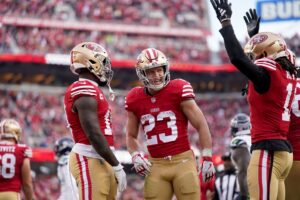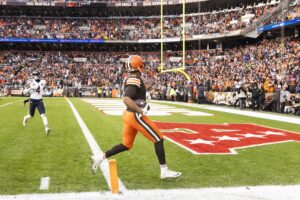What a difference a year makes. Last season, the Seattle Seahawks offense played exceptionally well, even though they did not achieve the desired results early. This year, the Hawks have achieved many victories despite an often anemic performance by the offense. Their late game red zone performance has produced mixed results during most of the regular season. Clutch play in the fourth quarter has bailed them out in some circumstances, while late game miscues have cost them in other situations.
Hit or Miss: Analyzing the Seattle Seahawks Late Game Red Zone Performance
A closer examination of Seattle’s fourth quarter play-calling reveals areas where the team has excelled, as well as places that need improvement. In the season opener, late game heroics by quarterback Russell Wilson and his favorite target Doug Baldwin gave the team the jump start they needed. The dominant Seattle defense deserves most of the praise for this victory, but to their credit, Seattle’s offense stepped up during the two minute drill. A fade route to the corner of the end zone resulted in a catch only Baldwin could make.
Fade routes are plays where the receiver runs toward the sideline opposite the direction of the quarterback, and they are a hallmark of head coach Pete Carroll’s offense. They were a staple of last year’s record setting performance, in which Baldwin set the franchise record for touchdown receptions, and Wilson and Baldwin combined to break Hall of Famers Brett Favre and Sterling Sharpe’s record for most touchdowns in a four-game span. These types of plays have the advantage in that, when executed to perfection, the defender is helpless to prevent a certain touchdown. The disadvantage to this type of play is that they are extremely difficult to master, and can result in disastrous consequences.
Risk and Reward
Less than stellar play by the Seahawks offensive line this season resulted in less efficiency in this type of play. Wilson does not have as much time to aim his pass, and the receivers do not have as much time to run their routes. As a result, the Seahawks have not hit the bull’s eye as frequently this year. An example of a missed fade route is the attempt from Wilson to wide receiver Jermaine Kearse against the New Orleans Saints in the game’s closing moments. With time running out, Kearse attempted a fade route, but caught the ball out of bounds. This play is an example where hurried attempts result in missed opportunities.
Another example of the fade route’s double edged sword occurred in week 15 against the Los Angeles Rams. Leading 10-3, the Seahawks opted for a passing play on first and goal from the one yard line. The attempted fade route to Jimmy Graham was nearly disastrous, and eerily reminiscent of the interception against the New England Patriots in Super Bowl 49. This play was controversial in many respects, and could have severely hampered the Hawks’ Super Bowl aspirations. Many observers felt the officials should have ruled the play an interception, especially after a challenge by the Rams. The outspoken Richard Sherman protested the Seahawks should not have called a passing play on first and goal near the goal line. “We’ve all seen how that goes,” Sherman stated afterwards. This remark was an obvious reference to a similar situation in Super Bowl 49, where Wilson threw an interception on first and goal in the closing seconds of the game.
Fortunately for the Seahawks, the pass was ruled an incompletion. Only two plays later, in yet another fade pattern, Wilson successfully completed a touchdown pass to a wide open Baldwin. These examples demonstrate just how risky these types of plays can be, even though they are sometimes successful.
Solid Play Is The Key To Avoiding Costly Errors
Hopefully, the Seahawks can avoid this risky behavior in the playoffs by playing the way they did against the Patriots. The Seahawks offense played so well in this game they did not need to take unnecessary risks. The offensive line blocked exceptionally well, opening up lanes for running backs Christine Michael and C.J. Prosise. Success on the ground led to even greater success in the air, capped off by a simple touchdown reception by Baldwin. In this late red zone play, Baldwin runs straight down the middle of the field, only side stepping once to fake out the defender. Wilson finds his favorite receiver running in stride down the center of the field for the game winning touchdown.
This type of solid play, rather than risky maneuvers, are what the Seahawks need if they are to make a deep run in the playoffs.






